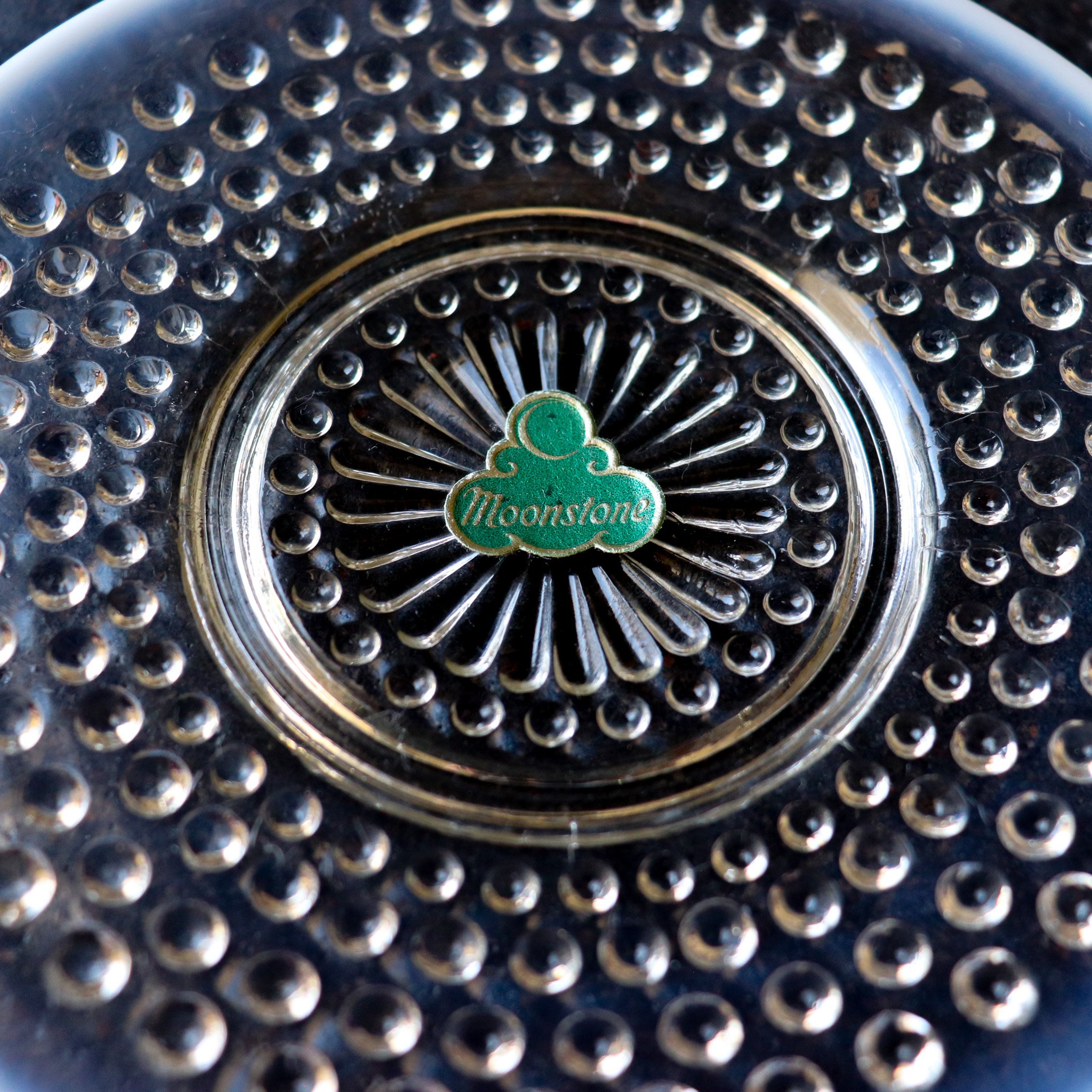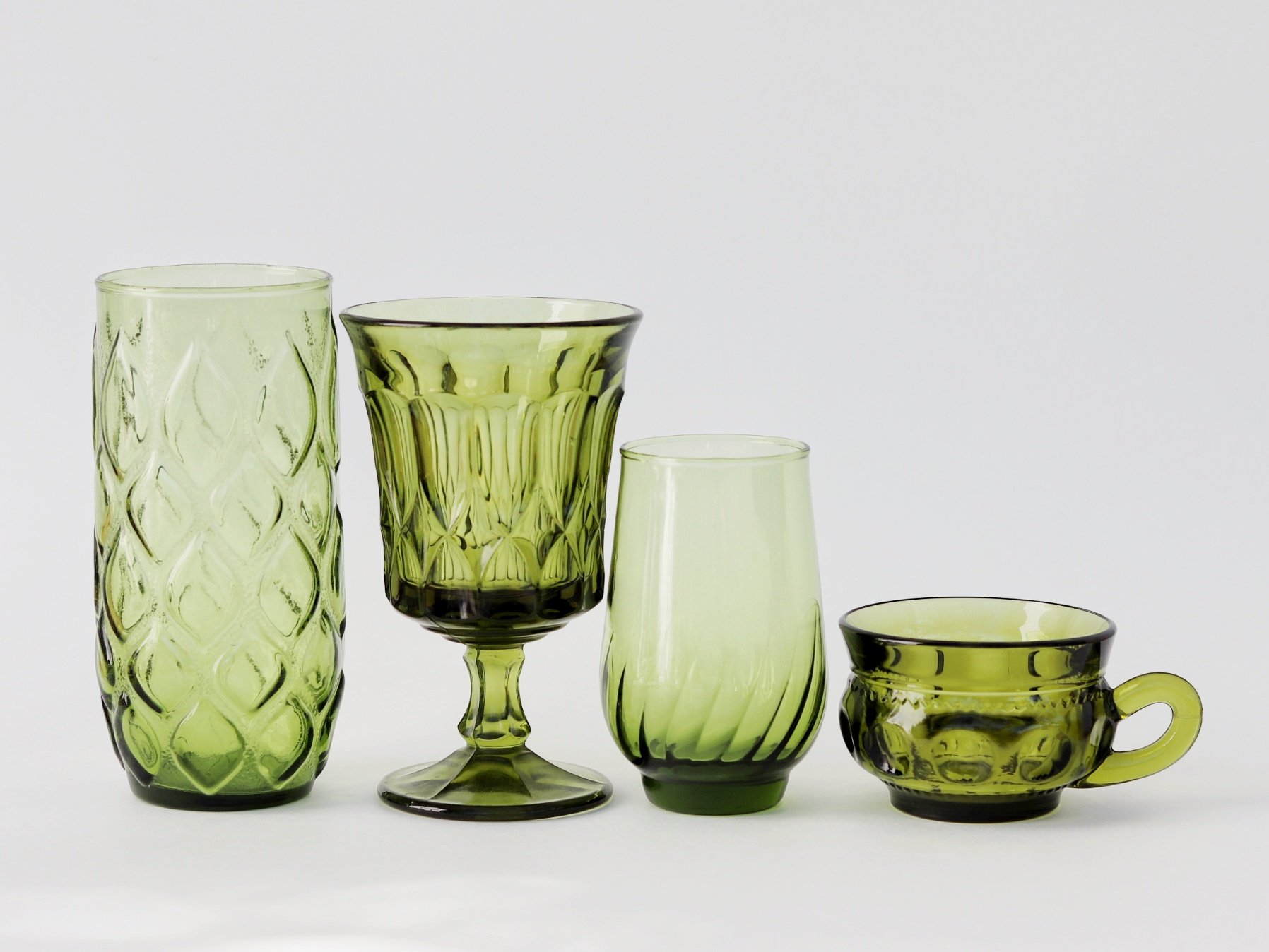Moonstone by Anchor Hocking
Unique insights about a war-era glass production off the Anchor Hocking manufacturing lines when women were America’s primary workforce.
Anchor Hocking is one of America’s oldest glass producers, and we are delighted to receive an expansive set of mint-condition artifacts in our available collection. When discovering more about the history and creation of this set, we reached back decades farther into history than usual and found some surprises along the way.
Anchor Hocking, the glassware manufacturer we know today, has a long history. It first came into existence in 1905 when Isaac J. Collins and six friends raised $8,000 to buy the Lancaster Carbon Company in Lancaster, Ohio.
We know that Anchor Hocking did not invent Hobnail glass. We have found that the hobnail style of glass manufacture was originally produced and popularized in the Victorian Era (the Downton Abbey 1830s to about 1900). Most agree that it was developed by an artist at Hobbs Brockunier and Co. in West Virginia in 1886 by first pressing glass into a mold with hobnails all over it and then hand-blowing and shaping the piece. This early form of hobnail glassware was known as Dew Drop Glass. Sometimes the tops of the "dew drops" were made opalescent by reheating the surface of heat-sensitive glass near the furnace, aka "glory hole." It was commonly made into pitchers with matching drinking glasses for elegant ladies' luncheons and picnics.
Anchor Hocking moonstone original sticker circa 1942-1946
Nearly 100 years later, during the great depression, Hocking set out to democratize the dew drop glass style and introduce hobnail to Americans outside of high society. Bright colors like pink, clear with red trim, and some pieces in ruby were providing a sense of luxury and cheer in hard economic times. It was nearly 10 years after they began producing hobnail glass that they began manufacturing their own Moonstone opalescent hobnail glass. This decade was needed for Anchor Hocking to develop a way to mass manufacture that elusive opalescent tipped look. A triumph in American manufacturing, the first pieces of Moonstone arrived in 1942, just after we marked the end of the Depression and the beginning of WW2.
With the war on an upswing, a large majority of American men were drafted to serve, and the remaining workforce was primarily comprised of women. It is not a far stretch to imagine that the hands that worked the glass pressing machines would have been women, quite a different scenario to the pink pieces manufactured just a decade earlier. These pieces are from an era prior to the significant post-war economic and style shift.
Anchor Hocking ruffled edge Moonstone Bowl and Dinner Plate circa 1940s
The Moonstone pattern, made from hobnail molds, features primarily transparent glass bodies with white opalescent glass highlights on the tips of the hobs and edges of each piece, sometimes reflecting shades of blue or amethyst. It took many forms, from traditional dinnerware pieces like plates and cups to impressive serveware, accessories, and table decor. Several of these pearlescent pieces, especially the tableware, host hyperfeminine ruffled edges, making for a striking display when a place setting is stacked. As was popular in the era, several serving pieces were divided to carry several small treats, and it was common for use with sweet and savory offerings. Large punch bowls were made for social gatherings, and though it was a century after the first hobnails came to be, elegant ladies still used matching pitchers and drinking glasses for luncheons and picnics. This time, though, they were catching daylight on their tables in the twinking opalescent glow of Moonstone.
Hocking continued production through 1946. A short run, making these particular pieces rare and collectible.
Opalescent hue shows and glows with different angles and light.
Why Vintage Glassware is Bursting with Vibrant Colors
In the past, glassmakers utilized various techniques to infuse colors into their creations.
Have you ever wondered why vintage glassware is bursting with vibrant colors while modern-day glassware tends to be mostly clear? 🤔 Let's explore the fascinating reasons behind this shift.
In the past, glassmakers utilized various techniques to infuse colors into their creations. They incorporated vibrant pigments like manganese, cobalt, uranium, and even gold during the glassblowing process. These elements created stunning hues, ranging from rich blues and greens to radiant reds and yellows. Vintage glassware truly reflected the creativity and craftsmanship of the artisans behind them.
However, as time went on, the demand for clear glassware increased.
Clear glassware gained popularity due to its versatility. It allowed the colors of the fine wines to take center stage and became preferred for formal occasions and fine dining.
Technological advancements played the most significant role. Developing more transparent glass formulas and refining production techniques made it easier to mass-produce clear glassware. This resulted in cost-effective (cheap!) manufacturing processes and broader availability for consumers.
Still, the allure of mouth-blown vintage glassware remains unparalleled. Especially if you already know the color of your favorite chard pretty damn well. The vivid colors found in vintage pieces add a touch of nostalgia and personality to any table setting. They evoke a sense of history and are cherished as collectibles, reminding us of the unique craftsmanship and design aesthetics of bygone eras and artists.
Raise a toast to the colorful past and the clear future of glassware! 🥂✨
The Science Behind the Blue Tint in Glass
Uncovering the Chemistry Behind the Stunning Blue Shades in Vintage Glassware
Blue vintage glassware captivates collectors and design enthusiasts alike with its rich, vibrant hues. But what exactly creates these stunning shades of blue? Understanding the chemistry behind blue glass reveals the artistry and craftsmanship involved in producing these timeless treasures.
How is Blue Glass Made?
The signature blue color in vintage glassware primarily comes from adding metal oxide compounds to molten glass during production. The most common is cobalt oxide, which yields a deep, intense blue prized in many collectible pieces. Alternatively, copper oxide can produce a softer, greenish-blue tone, adding variety to the blue spectrum.
Another sophisticated technique is cased glass, where a core of clear or colorless glass is encased in a colored glass layer. This method allows artisans to create layered blue hues with complex depth and luminosity, giving vintage glassware its unique character.
The Role of Fire and Flame
The type of flame used during the melting process also affects the final color. Variations like oxygen-enriched or reducing flames can subtly alter glass chemistry, influencing shade intensity and clarity. This meticulous control of heat and atmosphere speaks to the centuries-old expertise glassmakers employed to perfect their craft.
Why Does This Matter for Vintage Collectors and Enthusiasts?
Each piece of blue vintage glassware is not just a functional object but a work of art shaped by chemistry, technique, and history. Recognizing how these colors are achieved deepens appreciation for the skill behind every vintage bowl, vase, or goblet, making your collection truly one-of-a-kind.
Embrace Vintage Blue Glass for Sustainability and Style
Choosing vintage blue glassware adds more than just color to your home—it supports sustainable living by repurposing durable, quality pieces that have stood the test of time. These objects combine beauty and history, enriching your space with a story that modern mass-produced glass cannot match.
Why Vintage Glassware Belongs in Every Modern Home
Discover why vintage glassware is the ultimate sustainable addition to your home. Beyond its timeless style, vintage glassware offers unmatched durability and reduces environmental impact by cutting demand for new production. Learn how choosing vintage pieces not only elevates your decor with unique character but also supports eco-friendly living.
Why Vintage Glassware Is the Sustainable, Stylish Choice for Modern Living
In an era where sustainability and intentional design go hand in hand, vintage glassware offers more than just aesthetic value — it’s a conscious choice. Whether you're curating a shelf, setting a dinner table, or building a home with soul, vintage glass brings lasting beauty without the environmental cost of mass production.
The Case for Glass That’s Already Made
Every new object comes with a footprint — and glass is no exception. The production of new glass requires significant natural resources: sand, soda ash, limestone, and energy-intensive manufacturing. This process contributes to carbon emissions and ongoing resource depletion.
Choosing vintage glassware eliminates that impact. You're not asking the planet for anything new — you're choosing something that already exists. It’s a circular approach to consumption that values preservation over production.
Built to Last, Designed to Endure
Many vintage glass pieces were produced in an era when craftsmanship and durability were the default, not the exception. Whether it’s pressed glass from the Depression era, hand-cut crystal, or elegant mid-century tumblers, vintage glassware was made with care — and often with higher quality materials than what you’ll find on today’s shelves.
These pieces were built to be used — not just displayed — and their longevity proves it. With proper care, vintage glassware can serve beautifully for generations.
Style with Substance
There’s no substitute for the character that comes with age. From jewel-toned coupes to smoky amber tumblers, vintage glassware captures the design sensibilities of the eras it came from — 1930s Deco glam, 1950s hostess chic, or 1970s dinner party decadence. These pieces carry stories, and they invite you to create new ones.
Unlike mass-produced trends, vintage glassware stands out. It adds depth, history, and a layer of personal expression to your space — and no two collections are ever quite the same.
Tips for Buying Vintage Glassware
Inspect closely: Avoid cracks, deep scratches, or chips that may affect usability.
Research makers: Identifying the era or maker (like Blenko, Fostoria, or Libbey) can add value and context.
Buy what you’ll use: Whether it’s highball glasses for cocktails or cut-glass dessert dishes, choose pieces that suit your lifestyle.
The Bottom Line
Vintage glassware is more than a stylistic choice — it’s a sustainable design philosophy in action. By embracing what already exists, you're reducing waste, preserving quality, and investing in pieces that carry both history and integrity.
At CLAY+CODA, we believe good design is timeless — and vintage glassware proves it.













